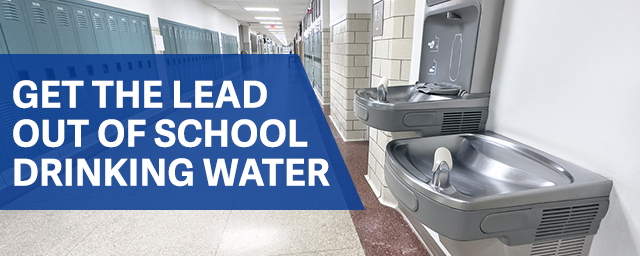Get the Lead Out of School Drinking Water

There is currently no known lead blood level for children without some level of risk. Lead exposure in children may cause adverse health effects such as brain and neurological development, behavioral problems, reproductive complications, and impaired growth.
One source of lead exposure may be drinking water caused by plumbing pipes, fittings, fixtures, solder, flux, or other components made with or containing lead. Over the last few decades, actions have been taken to reduce or remove lead and lead exposure in plumbing components through the Safe Water Drinking Act and subsequent amendments. However, in 2022, Missouri Legislation took a step forward in an additional effort to further reduce lead exposure in children by passing the Get the Lead out of School Drinking Water Act (RSMo 160.077) which sets standards for lead concentrations in school drinking water. This Act requires schools to conduct inventory, sampling, remediation, and monitoring at all potable drinking water outlets used or potentially be used for drinking, food preparation, and cooking or cleaning utensils. In addition this Act, Missouri Legislation also allocated $27 million to support schools in reducing lead concentrations in schools.
The Department of Health and Senior Services will continue its effort to provide information and resources available to schools as they become available.
Laws and Regulations
- RSMo 160.077 – Get the Lead out of School Act (2022)
- 40 CFR Part 143 Subpart B – Use of Lead Free Pipes, Fittings, Fixtures, Solder, and Flux for Drinking Water
Guidance
- Fact Sheet: Tips for Schools
- Frequently Asked Questions (updated 2/28/24)
- EPA’s Training, Testing and Taking Action program
- How to Identify Lead Free Certifications Marks for Drinking Water System & Plumbing Products
- Identifying Point of Use Drinking Water Filters
- NSF Certified Product Filter Listings for Lead Reduction
- NSF Lead Content Certified Products Catalog
Lead Health Publications and Education Material
- Department of Health and Senior Services
- Environmental Protection Agency
- Centers for Disease Control and Prevention
List of Approved Laboratories
Funding
The State of Missouri has allocated a one-time amount of $27 million to distribute to public school districts to support lead reduction in drinking water as mandated by the Get the Lead Out of School Drinking Water Act (RSMo 160.077). This Act sets standards for lead concentrations in school drinking water and requires a drinking water outlet inventory, sampling, remediation, and monitoring at drinking water outlets.
The Department of Health and Senior Services has established eligibility and distribution criteria as required by state statute and funding authority. Following are the eligibility criteria for fund distribution.
- Funds are available to public school and affiliated early education programs receiving state funding.
- Each school district is eligible to receive a minimum award of $5,000.00
- The maximum eligible award per district is based on the student enrollment during the 2022-2023 school year. Disadvantaged school districts are to be prioritized for this funding opportunity; prioritization is achieved by funding disadvantaged schools at a higher proportion of the per-student funds.
- Disadvantaged school districts are eligible for $61.40 per student. A disadvantaged school district is defined in RSMo 160.077 as:
- More than 70% of students in the district qualify for free and reduced lunch, OR
- 25% or greater of households within a county that the school district serves are below federal poverty guidelines.
- All other school districts are eligible for $20.47 per student.
Public schools can be reimbursed for eligible expenses incurred between March 3, 2021, and December 31, 2024. Public schools will be required to apply for reimbursement to receive such funds.
- Get the Lead Out of School Drinking Water Fund Allocation
- Application and Contract Guidance
- Online Contract Application
Contract Forms
Reporting
As provided in Revised Statute of Missouri (RSMo 160.077), all schools must submit testing results for lead concentrations in drinking water to DHSS. Those testing results and any remediation must be reported and summarized in the Get the Lead Out of School Drinking Water Reporting Portal in the link provided below. Prior to entering the reporting portal, schools should verify their drinking water outlet inventory and testing data to ensure format and organization of the data can be reported as summarized below.
Reporting should only be completed after all testing, and as necessary, remediation efforts are completed for the reporting year.
- Reporting year (August 1 - July 31). Any sampling efforts prior to August 1, 2023 will be reported in the August 1, 2023 - July 31, 2024 reporting year.
- File uploads of the official analytical test results and reports for each school. A prompt will be provided during the reporting process for the schools to upload these documents.
- The laboratory analytical lead detection level or reporting limit.
- Number of drinking outlets at each facility/campus location (elementary, middle, high school, etc.).
- Collective total number of all samples taken at each facility/campus location.
- Summary of drinking water outlet type greater than or equal to (≥) 5 ppb in the following outlet categories at each facility/campus location based on the initial sampling efforts.
- Water fountain, water cooler, bottle filler
- Kitchen outlets
- Classroom outlets
- Bathroom outlets
- Ice maker
- Hot drink machine
- Other outlets (any outlet not listed above such as outdoor spigots, showers, etc.)
- Number of remediated outlets, summary of remediation methods, and number of outlets sampled post-remediation at each facility/campus location.
Click the link to enter the Get the Lead Out of School Drinking Water Reporting Portal.
